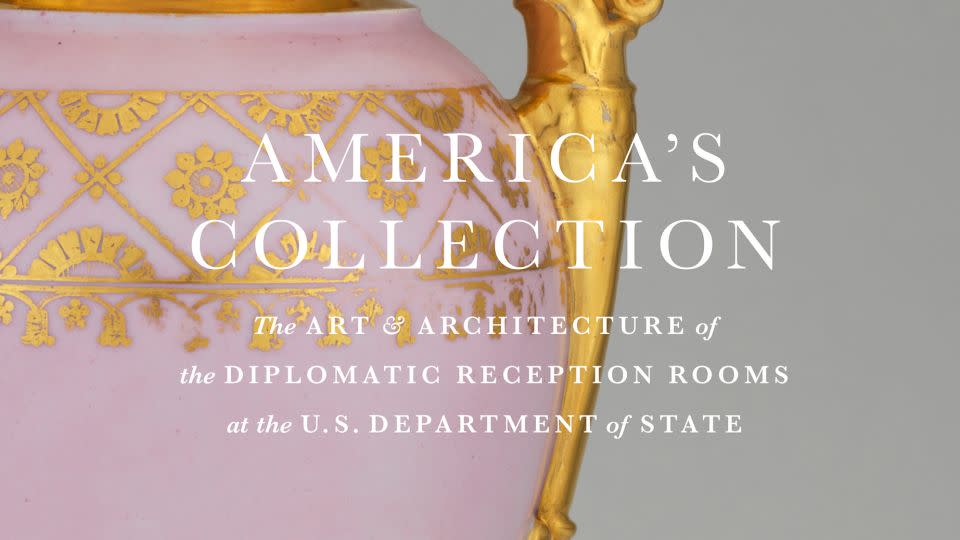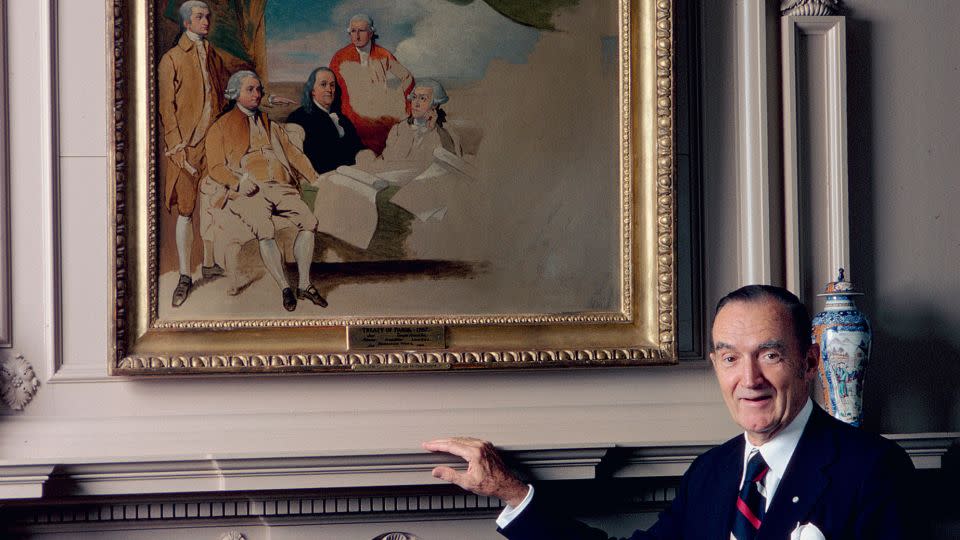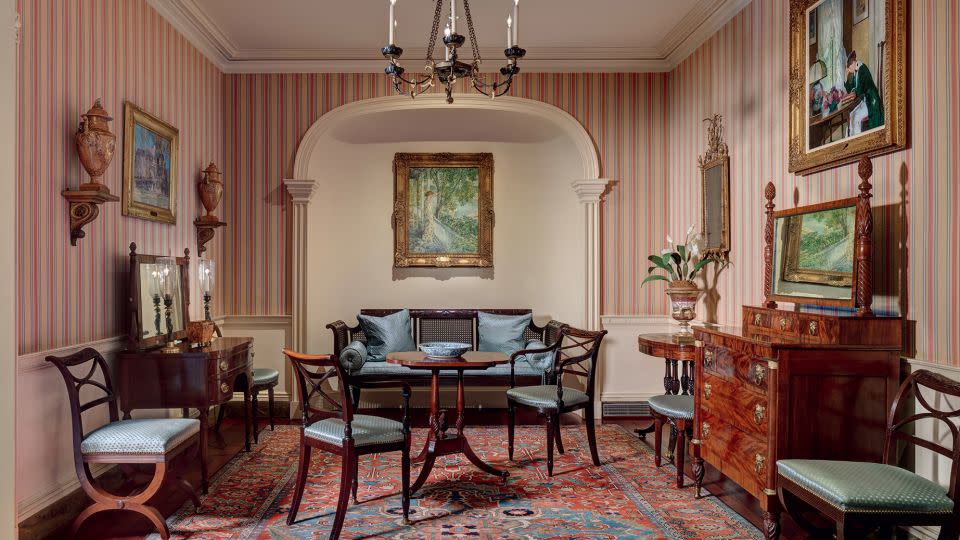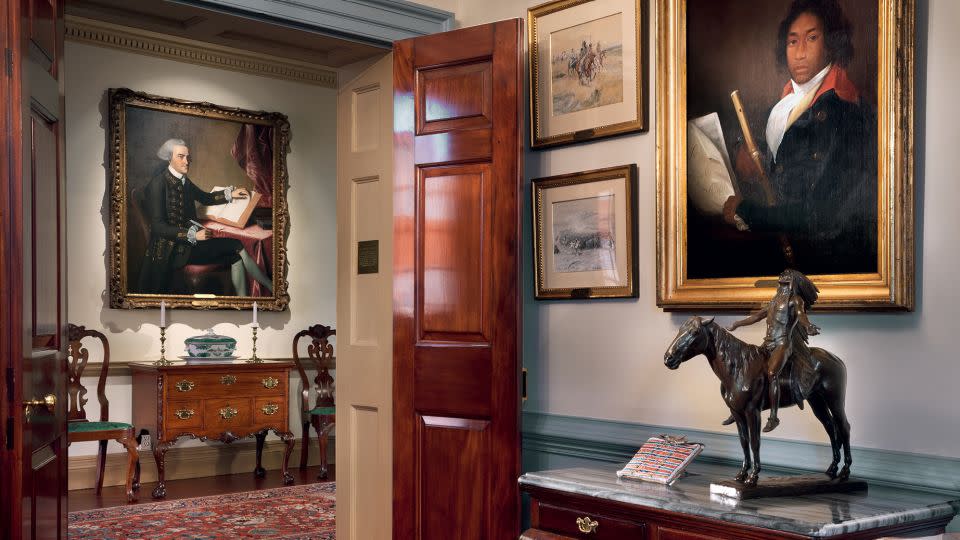The design of diplomacy: See inside the lavish reception rooms at the US State Department
- Oops!Something went wrong.Please try again later.
- Oops!Something went wrong.Please try again later.
Standing outside the modern, minimalist exterior of the US State Department’s Harry S. Truman Building in the nation’s capital, it’s difficult to picture the ornate reception rooms on its seventh and eighth floors.

It’s a dichotomy outlined in the opening pages of the new book “America’s Collection: The Art and Architecture of the Diplomatic Reception Rooms at the US Department of State.” Describing the building’s outward appearance, politely, as “massive, understated and ever so slightly aesthetically unappealing,” US Climate Envoy John Kerry, who previously served as secretary of state during the Obama administration, writes that many visitors to the building have no idea “of the treasures that can be found inside.”
And while Kerry notes that the Truman Building’s exterior is unassuming “by design,” the reception rooms inside are lavish for a similar reason: they provide the nation’s diplomats with “the biggest home field advantage, just one mahogany elevator ride away.”
That advantage, Kerry writes, allows guests to the State Department to “experience something akin to the moment in The Wizard of Oz when the picture changes from black and white to color.”
Rooms that take you back in time
“America’s Collection” gives those without diplomatic credentials a chance to experience that moment. (In-person tours are temporarily closed to the public, though visitors can also explore rooms online in a self-guided virtual walk-through.) The book offers a closer look at the rooms and collection, which includes an architect’s table said to have been used by Thomas Jefferson, furniture from the family of Francis Scott Key, author of the American national anthem, and silver crafted by Paul Revere for John Adams.
Its publication arrives amid the 240th anniversary of the Treaty of Paris, which ended the American Revolution in 1783 — a fitting moment because most of the Diplomatic Reception rooms take inspiration from that era.
The Truman Building was completed in 1941, with a State Department extension added by 1960. In both cases, the architects favored modern design styles, shying away from excessive embellishments and embracing an understated minimalism. The rooms’ original interiors featured dark wood paneling and pale carpet on the floor, with hardly any artwork on the walls.
But while the building’s design was oriented toward the future, curator Clement Conger and architect Edward Vason Jones looked to the past when tasked with the reception rooms’ renovation in the 1960s. Relying on private donations, both men set out to redesign the rooms and build an extensive collection of American art. Over the years, other curators and architects continued their work.

Essays in “America’s Collection” — written by architecture, art and design history experts — dive into each architect’s creative vision, highlighting details that allow readers to glimpse the nation’s past as they make their way through the rooms.
Take the entrance hall, for instance. It’s a space where many foreign dignitaries first enter on their way to meetings, lunches or state dinners. Echoing the decorative plasterwork, light-colored walls and ornate ceilings found in the houses and plantations of wealthy colonial-era Americans, Jones was able to transform a room that initially consisted of dark wood paneling and carpeted floor into a space that the country’s founders could have walked through.
On the 13-foot-high ceiling, visitors see intricate plasterwork made with molds taken from the Powel House in Philadelphia. The room also features examples of fine cabinetry, notably pieces made by the personal artisans of King George III, the British monarch in power during the American Revolution.
“Seeing the before-and-after photographs, one can scarcely believe the transformation was possible,” architect Mark Alan Hewitt writes in the book.
Another example is the John Quincy Adams State Drawing Room, which Jones designed to resemble a Revolution-era drawing room. Named after the nation’s sixth president and eighth secretary of state, the room was completed in the early 1970s, nearly two centuries after the period that inspired it. Four Ionic pilasters frame the room; bold furniture, upholstered in bright yellow and red hues, is placed throughout.
It’s here that Jefferson’s architect’s table can be found, as well as the desk on which the Treaty of Paris was signed. Portraits of Adams and his wife, Louisa Catherine, and George Washington and Martha Washington hang on the walls.
A new and modern story
Much of the book is dedicated to the Reception Rooms’ furniture and art, which a press release compares to the collections of New York’s Metropolitan Museum of Art and the Winterthur Museum and Library in Delaware, known for its focus on American decorative arts and antiques.
For Alexandra Kirtley, a curator at the Philadelphia Museum of Art who writes an essay in the book, the collection’s decorative arts — furniture, diningware and textiles, among others — in particular provide a valuable window into the past, because such pieces were both functional and stylish.
“When people lived with these works of art, they really functioned as sculpture in the room,” Kirtley told CNN.

For instance, patterns on porcelain from China would reappear on the fretwork along the walls of wealthy colonial homes, Kirtley explained. In other instances, architects and builders who helped construct rooms worked closely along with artisans tasked with creating furniture.
Learning more about the artisans behind these pieces also provides a deeper insight into the country’s past. In her essay in “America’s Collection,” Kirtley notes that some of the furniture in the Diplomatic Reception Rooms was likely made with the contributions of “unnamed, enslaved, indentured or free Black artists.”
The collection’s paintings show an energy and desire to not only meet the artistic standards of the day, but carve out a style that was uniquely American, Betsy Kornhauser, a curator at the Metropolitan Museum of Art who also authors an essay in the book, told CNN.
“There was a desire on the part of the American public, as well as these artists, to create an American art form that really dealt with the new history of the newly formed United States,” she explained.
Without access to formal training in the colonies, early American painters went to Europe to hone their craft. When they returned, their work echoed that of their European counterparts while being unburdened by long standing academic traditions, Kornhauser said.
“America’s Collection” showcases several landscape paintings in the reception rooms that are the result of that artistic energy, including work by Joshua Shaw and Thomas Cole, who helped build the country’s first artistic “fraternity” of sorts, the Hudson River School. In an undated Cole painting, “Indians in a Mountain Landscape,” tall mountains rise through a blue sky, as Native Americans stand a forest edge, steps from the water — though, like so many landscape paintings of the era, the work is also an example of how Native Americans were relegated to stereotypical portrayals to fit an idea of American nature that was wild and untamed.
The rooms do feature some pieces of Native American art, such as a beaded Apsáalooke saddle and a Cheyenne cradleboard. When asked whether current curators have had to reckon with how these works were sourced before being donated, Virginia Hart, curator of the Diplomatic Reception Rooms, told CNN, “While our collections policy did not address this specifically in the past, we are aware of the issue and our team here in the rooms is studying it.”
Future plans for the collection
One painting highlighted in the book that intrigues the museum’s curators is “A Flutist” — an anonymous work depicting a Black musician wearing a dark-colored coat with red lapels. The curators have had to rely on visual clues to learn more about the work. For instance, because he is not wearing a wig, pigtail or powder on his hair, experts can theorize that the painting could have been made after 1795.

While identifying anonymous artists of furniture or paintings is difficult, presenting the works allows viewers to deepen their understanding of the version of American history they bring to the rooms.
“If we simply put history in the closet instead of understanding it better, we’re not going to get anywhere,” Kirtley said. “So, it’s really important that these works of art aren’t just newly presented and newly understood but that they shouldn’t be put away.”
At the Diplomatic Reception Rooms, there are plans in place to grow the collection and add works from artists who have been overlooked in the decades since curatorial efforts first began, such as women and people of color. Those efforts allow for the presentation and preservation of a more inclusive array of early American art, and will offer a more accurate representation of the nation’s history to foreign diplomats on future visits.
“We’re learning through history,” Hart said. “Everyone here at the department is really furthering the nation in fundamental ways. And this collection is one small part of that larger mission at the Department of State.”
America’s Collection: The Art and Architecture of the Diplomatic Reception Rooms at the US Department of State, published by Rizzoli Electa, is available now.
For more CNN news and newsletters create an account at CNN.com

